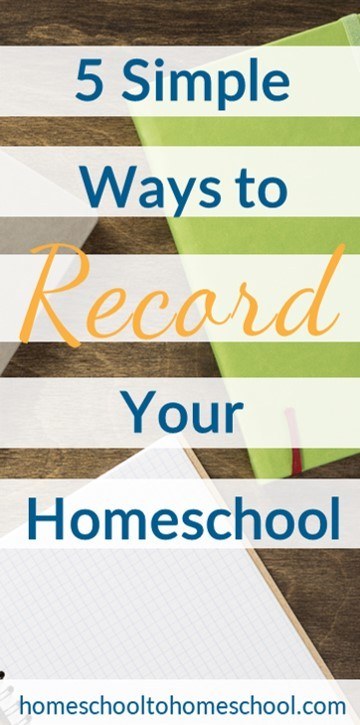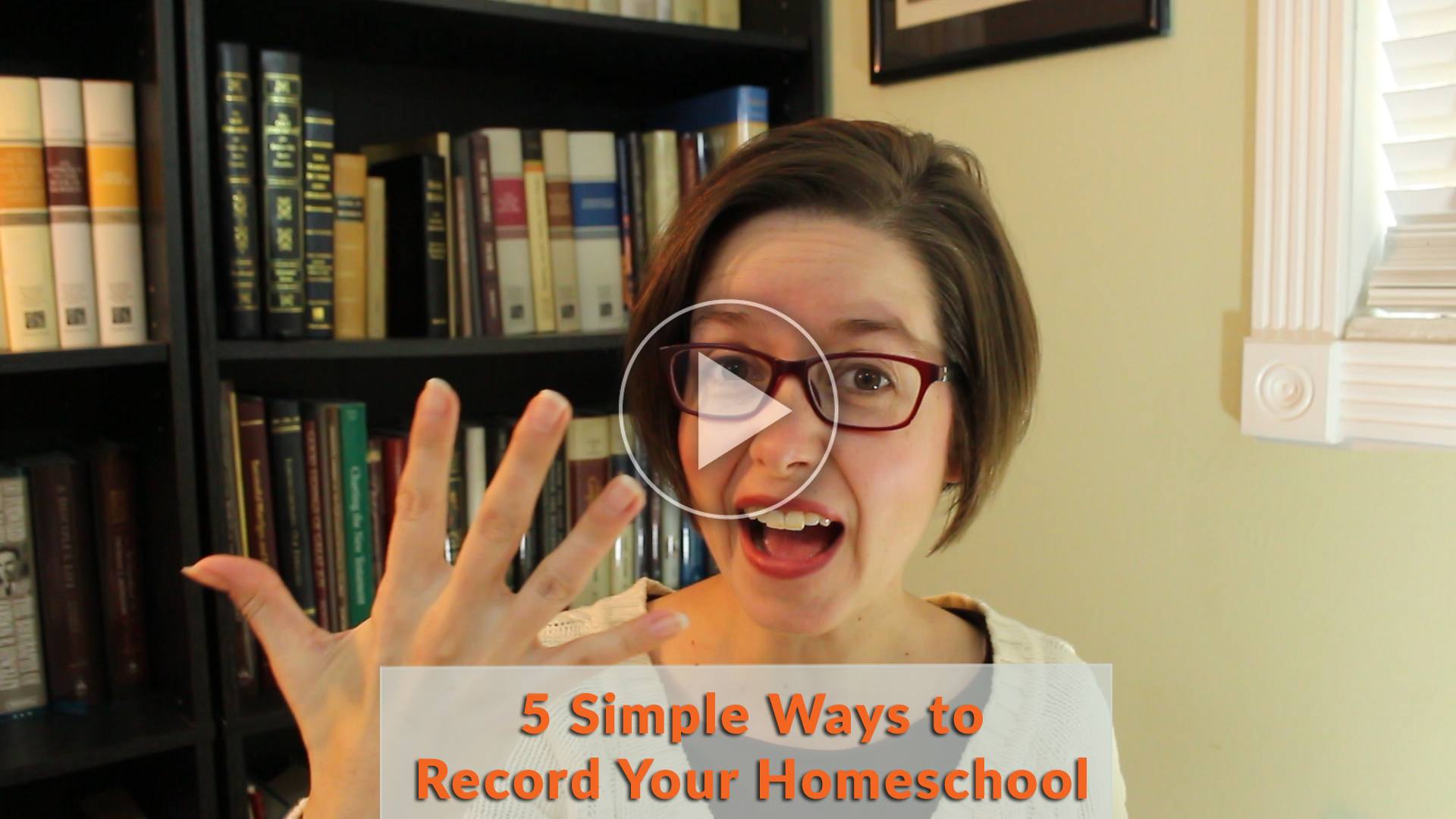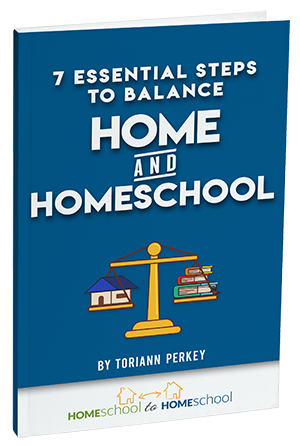Homeschool record keeping … you know you should do it.
But after the homeschool planning and the homeschool doing, finding the time and the energy to remember and want to record what actually happened can feel exhausting and overwhelming.
And no matter how many free homeschool record keeping templates you download, you never quite get around to really making them work.
Never fear! There is hope.
While I’ve never been perfect at documenting our homeschool, I will say that over the years, I have been fairly successful at capturing the overall picture of what we have done.
I’m really lucky to live in a state where I don’t have to submit any kind of records, so the record keeping is purely for me. But I still think keep track of what we’re doing in our homeschool is important.
So today I’m sharing 5 simple ways you can create records for your homeschool. I’ve done all of these methods during the last 15 years, and I don’t necessarily have a favorite.
But I’m so so so glad that I took the time to keep track of what we did along the way. Now that my kids are older, I love reminiscing and remembering our homeschool over the years … from when we were first starting out and I had mostly toddlers and babies, to just last year when I had everyone still at home and they were all teenagers.
Seriously … even if you are super disorganized or overwhelmed, one of these 5 ways can work for you!
Want to keep reading instead of watch? Scroll to read a transcript of the video.
Ready to feel Confident and Successful as you homeschool?
Register below to watch my FREE CLASS
Confident Homeschool Secrets
7 Ways to Create a Homeschool That Works (and you LOVE!)
Transcript
Hello, this is ToriAnn Perkey, and from my homeschool to your homeschool, today I want to talk about 5 simple ways that you can record your homeschool.
So there's a lot of conversation in the homeschool world about planning, about deciding what you're going to do, getting all set up. I don't know that we spend quite as much time talking about recording. And depending on where you live, you may or may not be required to record. And if you're not required to record, then it is something that is easy to not get around to because you're so busy actually doing the homeschool thing.
And so today I want to talk about 5 simple ways to do it. And the reason I'm making this video and I'm talking about this is because recording your homeschool can be really important for a couple of reasons.
Now, first of all, you may live in a state where you do actually have to keep records and turn those in. And if that's the case, then you're going to need probably a more extensive system than something that I'm going to talk about today. But there's a lot of places where that is not required.
Why It's Important to Keep Records in Your Homeschool
So why else would you record your homeschool? Well, first of all, when you record your homeschool, it gives you a place to go back and look on those days -- or even those weeks -- when you're thinking, Why am I doing this? Why am I putting myself through the stress and the struggle and the frustration and ... ? Or you're thinking, I'm failing at this. I'm not doing well. We're not making any progress.
When you're feeling like that, if you have a record, you can go back and you can look at it and you can remember the high points. You can remember that, Oh yeah, it used to be that my child couldn't read and now they can read. Or it used to be that we were struggling and struggling and struggling to learn how to do, you know, long addition. And now my kid is way past that. You know, whatever it is that you have progressed through, a record helps you remember. Because we as human beings are really bad at remembering. We think we'll remember, but we don't. So having a record helps you do that.
The other reason that you might want to keep a record is particularly as your kids get older, they're going to start to apply for things. They're going to want to be in things, and sometimes it's really, really helpful to be able to go back and see what they actually did. And because, again your memory is fallible, which means that it will be helpful if you have something to reference. But having said that, we need to keep record keeping simple, otherwise you can go crazy trying to keep up with the planning and the doing and the record keeping.
1. Simple Daily Journal
So now we're going to get into 5 simple ways to do record keeping. You ready? All right, number 1. Get a journal. Doesn't have to be fancy. It can be the cheap one that you picked up at the discount store, or it can be a nice leather bound one, whatever. And just jot down a few things as many as many times a week as you can remember to do it. You might want to set an alarm on your phone or something. And I'm not talking about pages and pages of journal entry. It could simply be the highlight of the day or one thing you noticed, one success, one thing you wish you'd done differently. So it's more of a reflective journal than otherwise.
Now you can keep a journal like that in paper form, like I said, or you can also keep it on your phone. You could put it in a Google doc, you could put it in any one of those record keeping systems that store it up in the cloud. And then you just add a little bit every single day or as often as you remember. So the first suggestion I have is to do some kind of just mini journal, mini journal. Remember, we're going to keep this simple.
2. Take a Picture
Okay, number 2. The second thing that you could try is take a picture every day with cameras in our pockets and in our hands all day long. Because let's be honest with one another, we all kind of have our phones with us all the time. It's so easy to take a picture. And it doesn't have to be an Instagram worthy picture. It's a picture of whatever you happen to do that day. Maybe it's a picture of the mess after the activity was over. Maybe it's the finished art project. Maybe it's the messy hands. Maybe it's just the kids sitting on the couch reading. Or maybe it's just a selfie that you take with you and your kids as you're driving in the car.
If you take a picture, then you start to have a record of just the dailiness of homeschool and all of the things that go along with that. And then you can store those in the cloud again, or you can put them on one place on your computer, hard drive. And you can just go back through those and they can be a recollection of the memories that you've made throughout your homeschooling. So that's number two. Take a picture as often as you can, possibly every day.
3. Notes on Your Lesson Plan
All right, number 3. The third easy way to do simple record keeping is to make comments on your lesson plan. So if you have somewhere that you're keeping track of what you want to do every day, then in the margins or down-- if there's a space provided, you're just going to jot down again, How did things go today? Well, Johnny read four letters, or I was really excited because we actually had an activity where everybody had a good time. Whatever it is, you're going to just jot a few thoughts.
It's similar to number one with the journal except that it's put in the lesson plan. It's combined with the planning so you can go back and you can see not just what you did but also what you had planned to do. The bonus of this particular system is that you can often see how maybe the plan for the day didn't necessarily line up with what actually happened, but maybe it was still good day. And maybe it wasn't. And if it wasn't a good day, jot that too.
Because part of the process of record keeping is to see the good, the bad and the ugly. And if you're able to see that there were not such great days but you got through them and then you had another great day, it helps program your mind to remember there's another good day coming. So number three is to just jot a couple notes in the margin or in a space provided in your lesson planner.
4. Record Audio or Video
Number four, the fourth way to do some easy record keeping in your homeschool is to do video or audio. So you get your phone out and you push the little record button on the audio record app that you can put on your phone and you just take a journal -- you just talk for a few minutes about the good and the bad and everything in between.
Or you take a video of some of the things that are happening during the day with you narrating in the background. Another way to handle this is to actually hand the phone over to your child or your children and say, Hey, just talk today about what happened. Give a couple of sentences. Again, we're not making this to be a movie. You're making this as a record, as a keepsake.
And one of the benefits is that audio and or video capture so much more than words. They capture personality, they capture the tone of the voice, they capture the stages that your child is in. It's kind of like a big trove of family history, all squished into that little homeschool package. And because homeschool does actually bleed into all parts of our lives, you'll actually get a capture-- You'll actually end up capturing what is going on on a regular basis just in your home.
And again, we're not doing this all the time. We're doing this whenever you remember. And if it's important to do it regularly because you do want that record, you know, set a reminder on your phone or something like that to help you remember. You just want to put five minutes into this at some point during the day. So number four is actually to use video or audio and then to store that somewhere in one place where you can find it. Okay?
5. Create a Simple Portfolio
Number five, the fifth way that you can do some simple record keeping in your home is to create some kind of portfolio. Now when I say portfolio, sometimes what happens is we think about the kind of portfolio that has to be turned in, which means that it will be beautifully decorated and all formatted and in order. And that is not what I'm talking about.
I'm talking about the kind of portfolio where you get a binder and you just have sheet protectors or even a three hole punch and you just throw things in as they're created. This is especially fun to do when your kids are creating lots of things in art or they're sitting down and writing simple stories and as they get older they can put their papers that they write in there or you can print out pictures of things you've done. So it becomes kind of like a scrapbook.
Or even simpler -- I think of this as a portfolio, but I think of it as as a vertical portfolio rather than as a book -- is to get a bin and as people, as people in your home, as children create things to put them in the bin and you store it archaeologically. So if you want to be able to go through and see when that program happened or when that child made that art project, what's at the top will be what was created most recently. And then you go down from there and you just store things. And again, don't store everything, right? As prolific artists, prolific writers, you can't store everything. We are going to store the things that have meaning.
And anything you store, take a minute to just date and write a sentence on it about what it is. Because again, when you look at it five years from now, you think you'll remember, but you won't. So there you have it. That's the fifth one. Create some kind of portfolio, either either in a notebook or a binder or archeologically in a bin.
Five ways to do simple record keeping. Because when you keep records, you remember, and when you remember, you are able to have a better perspective. You're able to have a healthier attitude about your homeschool, and you'll also be able to look back and remember and enjoy all of the good experiences that you are slowly accumulating on your homeschool journey. I'm ToriAnn Perkey, and from my homeschool to your homeschool, I make these videos every week so that you can be a successful and confident homeschool mom.
Save for later by pinning to your favorite Pinterest board!





